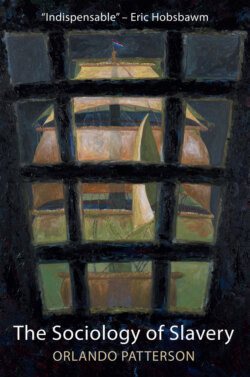The Sociology of Slavery

Реклама. ООО «ЛитРес», ИНН: 7719571260.
Оглавление
Orlando Patterson. The Sociology of Slavery
CONTENTS
Guide
List of Illustrations
List of Tables
Pages
Dedication
The Sociology of Slavery. Black Society in Jamaica, 1655–1838. With a new Introduction
INTRODUCTION1 Life and Scholarship in the Shadow of Slavery
PREFACE
CHAPTER I The Masters: An Overall View of Slavery
SECTION 1 THE DEVELOPMENT OF JAMAICA, 1655–1834
SECTION 2. POLITICAL DEVELOPMENT AND STRUCTURE
SECTION 3. THE WHITE SOCIETY DURING SLAVERY
CONCLUSION
CHAPTER II The Slave Plantation ITS SOCIO-ECONOMIC STRUCTURE
SECTION 1. DESCRIPTION AND ESTIMATED COSTS OF THE PLANTATION WORKS
SECTION 2. THE PERSONNEL
SECTION 3. ANNUAL AND DAILY CYCLE OF WORK
CHAPTER III The Treatment of the Slaves in Law and Custom. INTRODUCTION
SECTION 1 THE LEGAL BASIS OF SLAVERY
SECTION 2. THE DEVELOPMENT OF THE SLAVE LAWS
SECTION 3. THE NATURE OF THE LAWS IN THEIR RELATION TO THE ACTUAL CONDITION OF THE SLAVES
CONCLUSION
CHAPTER IV An Analysis of the Slave Population of Jamaica
CHAPTER V The Tribal Origins of the Jamaican Slaves
PART I. THE SOURCES OF THE SLAVE POPULATION. SECTION 1. THE TRADING AREAS OF WEST AFRICA
SECTION 2 THE GENERAL PATTERN OF BRITISH TRADING 1655–1807
PART 2 THE DEMAND FOR SLAVES IN JAMAICA
GENERAL CONCLUSIONS
CHAPTER VI The Socialization and Personality Structure of the Slave
SECTION I. CREOLE AND AFRICAN SLAVES
SECTION 2. THE ADJUSTMENT OF THE AFRICAN SLAVE
SECTION 3. THE SOCIALIZATION OF THE CREOLE SLAVE
SECTION 4 MATING PATTERNS, PARENT-CHILD RELATIONS, KINSHIP, AND THE WHITE OUT-GROUP
SECTION 5. AN ANALYSIS OF ‘QUASHEE’
CHAPTER VII Social Institutions of the Slaves 1. WITCHCRAFT, SORCERY AND RELIGION
PART I. SUPERNATURAL BELIEFS AND PRACTICES OF AFRICAN ORIGIN
PART 2: CHRISTIANITY AND THE SLAVES
CHAPTER VIII Social Institutions of the Slaves 2. ECONOMY, RECREATION AND CONTROL
SECTION 1. THE ECONOMIC LIFE OF THE SLAVES
SECTION 2: INTERNAL PATTERNS OF CONTROL
SECTION 3: THE RECREATIONAL PATTERNS OF THE SLAVES
CHAPTER IX The Mechanisms of Resistance to Slavery
PART I PASSIVE RESISTANCE
PART II. VIOLENT RESISTANCE
CHAPTER X The Cultural and Social Development of Jamaica 1655–1865
APPENDIX 1
APPENDIX 2
APPENDIX 3
APPENDIX 4
APPENDIX 5
Official Publications
Other Official Publications
PLATE CREDITS
INDEX. A
B
C
D
E
F
G
H
I
J
K
L
M
N
O
P
Q
R
S
T
U
V
W
Y
POLITY END USER LICENSE AGREEMENT
Отрывок из книги
For C. L. R. JAMES
West Indian history had just begun to find a place amid the imperial history that still dominated the colonial curriculum of my primary school with its Royal Readers, as well as my secondary education, focused on British history and literature, and I seized every chance to study it. My very first research project was a study of the Morant Bay rebellion, the revolt of former Jamaica enslaved in 1865 that was ferociously put down by the colonial authorities, savagely aided by the Maroons. It won the national essay prize of the Jamaica History Teachers’ association in 1957 and confirmed my decision to study history should I win a scholarship to the recently formed University College of the West Indies. I did win a scholarship to the university, but to my great disbelief, in a typical act of learned imperial arrogance, the Black, Naipaulian mimic men who then ran the university ordered me to major in economics, which was being instituted for the first time in my freshman year and did not have enough applicants, my pleas and those of my distraught high-school history master simply brushed aside. Fortunately, the Economics Department was really an inter-disciplinary group dominated by two eminent social anthropologists, R. T. Smith and M. G. Smith, the sociologist Lloyd Brathwaite, and the demographer George Roberts. All recognized the centrality of history and enslavement for any understanding of the Caribbean. This included the economists of the department, George Cumper and, later, George Beckford. Indeed, Beckford saw the slave plantation and its later developments as so critical for any understanding of West Indian economy that he developed, along with the economist Lloyd Best, what became known as the ‘Plantation Model’ of the Caribbean economy and society. In addition to these interdisciplinary scholars, with whom I was later to work in the New World Group of Caribbean intellectuals, I developed strong friendships with fellow students who shared my historical view of Caribbean scholarship, particularly the political economist Norman Girvan and the historian Walter Rodney.
.....
One pleasant surprise is the degree to which slaves from Ghana dominated the period between 1700 and 1740. I had argued, along with the creole linguists, that this was the period in which the creole language and Afro-Jamaican culture was at its most formative stage and the major presence of slaves from Ghana during this time would have meant that their impact would remain lasting, even if their numbers were later surpassed by enslaved persons from Nigeria. This argument is now strengthened.
However, not everything went my way with these latest data. The biggest surprise is the fact that during the 17th century 6,853 of the Jamaican enslaved came from South East Africa! No one saw anything like this during the 20th century. Indeed, it was considered a near certainty that hardly anyone came from South East Africa to the islands, or to North America (what the Portuguese slavers were up to in South America and Southern Africa was anybody’s guess at that time). That clearly was not the case. However, they were soon overwhelmed by slaves from West Africa and there is no trace of their cultures or languages in the creole culture of Jamaica, then or now.
.....